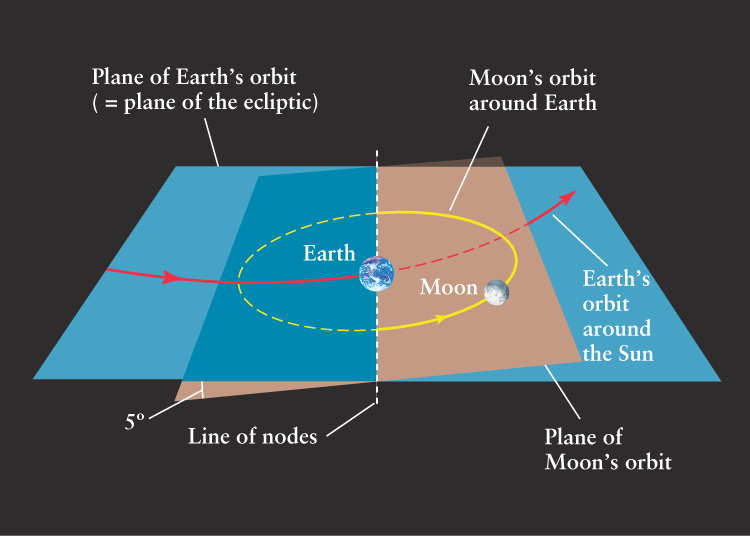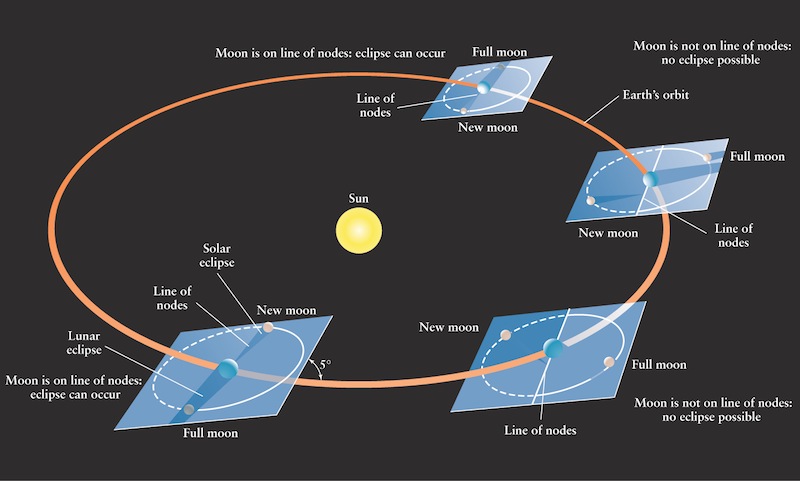3-3 Eclipses occur only when the Sun and Moon are both on the line of nodes
The tilt of the Moon’s orbit makes lunar and solar eclipses rare events
 From time to time the Sun, Earth, and Moon all happen to lie along a straight line. When this occurs, the shadow of Earth can fall on the Moon or the shadow of the Moon can fall on Earth. Such phenomena are called eclipses. They are perhaps the most dramatic astronomical events that can be seen with the naked eye.
From time to time the Sun, Earth, and Moon all happen to lie along a straight line. When this occurs, the shadow of Earth can fall on the Moon or the shadow of the Moon can fall on Earth. Such phenomena are called eclipses. They are perhaps the most dramatic astronomical events that can be seen with the naked eye.
A lunar eclipse occurs when the Moon passes through Earth’s shadow. This occurs when the Sun, Earth, and Moon are in a straight line, with Earth between the Sun and Moon so that the Moon is at full phase (position E in Figure 3-2). At this point in the Moon’s orbit, the face of the Moon seen from Earth would normally be fully illuminated by the Sun. Instead, it appears quite dim because Earth casts a shadow on the Moon.
A solar eclipse occurs when Earth passes through the Moon’s shadow. As seen from Earth, the Moon moves in front of the Sun. Once again, this can happen only when the Sun, Moon, and Earth are in a straight line. However, for a solar eclipse to occur, the Moon must be between Earth and the Sun. Therefore, a solar eclipse can occur only at new moon (position A in Figure 3-2).
CAUTION!
Both new moon and full moon occur at intervals of 29½ days. Hence, you might expect that there would be a solar eclipse every 29½ days, followed by a lunar eclipse about two weeks (half a lunar orbit) later. But in fact, there are only a few solar eclipses and lunar eclipses per year. Solar and lunar eclipses are so infrequent because the plane of the Moon’s orbit and the plane of Earth’s orbit are not exactly aligned, as Figure 3-6 shows. The angle between the plane of Earth’s orbit and the plane of the Moon’s orbit is about 5°. Because of this tilt, new moon and full moon usually occur when the Moon is either above or below the plane of Earth’s orbit. When the Moon is not in the plane of Earth’s orbit, the Sun, Moon, and Earth cannot align perfectly, and an eclipse cannot occur.

In order for the Sun, Earth, and Moon to be lined up for an eclipse, the Moon must lie in the same plane as Earth’s orbit around the Sun. As we saw in Section 2-5, this plane is called the ecliptic plane because it is the same as the plane of the Sun’s apparent path around the sky, or ecliptic (see Figure 2-14). Thus, when an eclipse occurs, the Moon appears from Earth to be on the ecliptic—this is how the ecliptic gets its name.
The planes of Earth’s orbit and the Moon’s orbit intersect along a line called the line of nodes, shown in Figure 3-6. The line of nodes passes through Earth and points in a particular direction in space. Eclipses can occur only if the line of nodes points toward the Sun—that is, if the Sun lies on or near the line of nodes—and if, at the same time, the Moon lies on or very near the line of nodes. Only then do the Sun, Earth, and Moon lie in a line straight enough for an eclipse to occur (Figure 3-7). Note that the alignment necessary for eclipses has nothing to do with either the solstices or the equinoxes.
 Anyone who wants to predict eclipses must know the orientation of the line of nodes. But the line of nodes is gradually shifting because of the gravitational pull of the Sun on the Moon. As a result, the line of nodes rotates slowly westward. Astronomers calculate such details to fix the dates and times of upcoming eclipses.
Anyone who wants to predict eclipses must know the orientation of the line of nodes. But the line of nodes is gradually shifting because of the gravitational pull of the Sun on the Moon. As a result, the line of nodes rotates slowly westward. Astronomers calculate such details to fix the dates and times of upcoming eclipses.

 Conditions for Eclipses Eclipses can take place only if the Sun and Moon are both very near to or on the line of nodes. Only then can the Sun, Earth, and Moon all lie along a straight line. A solar eclipse occurs only if the Moon is very near the line of nodes at new moon; a lunar eclipse occurs only if the Moon is very near the line of nodes at full moon. If the Sun and Moon are not near the line of nodes, the Moon’s shadow cannot fall on Earth and Earth’s shadow cannot fall on the Moon.
Conditions for Eclipses Eclipses can take place only if the Sun and Moon are both very near to or on the line of nodes. Only then can the Sun, Earth, and Moon all lie along a straight line. A solar eclipse occurs only if the Moon is very near the line of nodes at new moon; a lunar eclipse occurs only if the Moon is very near the line of nodes at full moon. If the Sun and Moon are not near the line of nodes, the Moon’s shadow cannot fall on Earth and Earth’s shadow cannot fall on the Moon.
There are at least two—but never more than five—solar eclipses each year. The last year in which five solar eclipses occurred was 1935. The fewest eclipses possible (two solar, zero lunar) happened in 1969. Lunar eclipses occur just about as frequently as solar eclipses, but the maximum possible number of eclipses (lunar and solar combined) in a single year is seven.
CONCEPT CHECK 3-6
Why don’t lunar eclipses occur each time the Moon reaches full moon phase?
Lunar eclipses only occur when the Sun, Earth, and Moon all lie exactly on a line; this line is called the line of nodes. As shown in Figure 3-7, during a full moon the Sun, Earth, and Moon are not necessarily lined up because the Moon orbits in a different plane than the ecliptic. Usually, the full moon is above or below the ecliptic plane of Earth’s orbit around the Sun and misses being covered by Earth’s shadow.